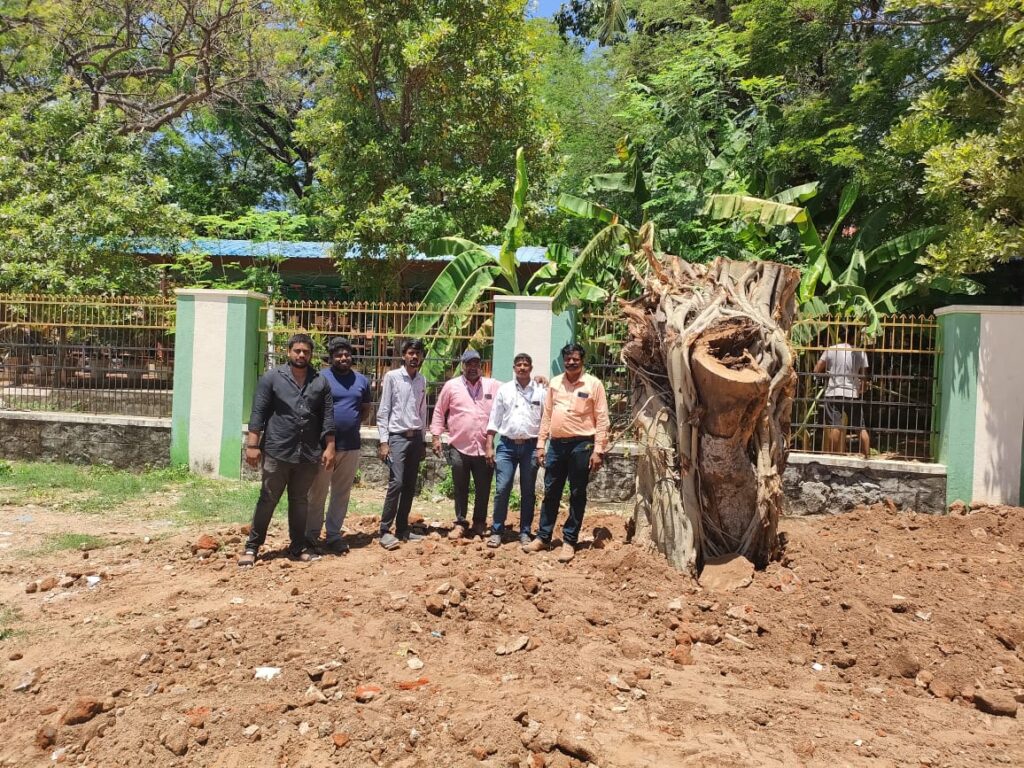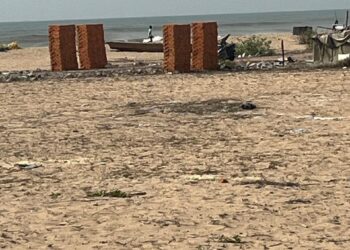Gandhi Nagar residents’ conviction triumphs as GCC and Horticulture department transplants a fallen tree in a first-of-its-kind initiative.
By R.Swathi
On June 19, a decades-old African Sausage tree (Mara Suraikai in Tamil), at B.Ramachandra Adithanar Road, fell down during the heavy rains that lashed the city. The tree, which was already infected with fungus, had further weakened during the storm water drain construction. The winds and thunderstorms that week proved catastrophic for it.
T.D.Babu, Trustee of NGO Nizhal, had been monitoring the tree for nearly two decades and narrates its uniqueness, “The original tree having its root into the ground is actually African Sausage. However, a fig tree (Ficus) has grown out from one part of the tree, possibly from bird droppings. This fig tree was thriving on the African Sausage like a parasite, thus weakening the tree. The Corporation had been informed about this unique situation and frequent requests had been made to ensure that the trees thrive (through pruning etc. for load bearing).”
During the construction of the stormwater drains (SWD), the roots were disturbed and the surroundings were damaged. “A resident residing close to the tree monitored the tree and informed us about its health. When the tree fell, he was the first to alert us of it,” explains Babu.
Generally the Corporation cuts a fallen tree into logs, but residents of Gandhi Nagar wanted to transplant the tree so that it gets a second chance to live. The Nizhal team suggested that the fig tree was healthy and had a high chance of survival if transplanted. But the African Sausage would not, since it was already infected.
Meanwhile, Meera Ravikumar, a resident of Gandhi Nagar, tagged the necessary officials on Twitter for attention and followed up as well. The area had been cordoned for safety. The road being a busy one due to the presence of many educational institutions, the Chennai Traffic Police wanted to clear the tree as soon as possible, but the residents were in no hurry, as saving the precious life was more important. The passionate residents thus followed up with the GCC and the Horticulture department to hurry up the transplantation. Their conviction was fueled by the encouragement received ADH Niresh Kumar from the Horticulture department.

Finally on June 28, the tree was transplanted to the Kotturpuram park area, opposite the Miyawaki forest. “A huge old Ficus tree which was in the Adithanar Road, Gandhi Nagar, was uprooted during the recent rains. The GCC team has carefully moved the tree to the Kotturpuram dense forest near the playground and have replanted the tree,” said a statement from the Greater Chennai Corporation (GCC).
“This was the first time in the history of GCC that a fallen tree was given a second chance in life through transplantation. This effort by the residents must be appreciated for not only their persistence, but also their efforts in preserving the tree till the transplantation,” points out Babu, while adding that all is not yet over, “The post-care of the tree is crucial. Since it germinated from an infected branch and has been transplanted along with it, antifungal and antibacterial medicines have to be sprayed regularly. Also, because the climate is still hot, the plant needs to be watered frequently, till it flourishes. In these efforts, the involvement of the local residents is also essential.”
The happiness was also evident in the voices of residents of Gandhi Nagar as Vinay Kamath tweeted, “A wonderful effort! An old fig tree had collapsed at the intersection of BR Adithanar Road and 1st Crescent Park Road, Gandhi Nagar. Due to SWD work, its roots were cut. Now, the Corporation and Horticulture department transplanted it to Kotturpuram. Great work.”
Meera Ravikumar also appreciated the team work and said, “Trees seem to be the silent victims of so called infrastructural and developmental works in and around urban areas. It’s important to be inclusive and protect the greenery while we plan any construction work. Be kind to the trees as they are here, doing a thankless job of protecting us from the rising temperatures and reducing carbon footprints. They are here, busy saving the planet.”
The transplantation of the tree is a first, but shouldn’t become the last. GCC has just paved a way to show that other trees that fall due to various reasons can be transplanted too at various places. Along with sapling plantation, transplantation should also be part of the city’s greening efforts. Also, as Babu and the passionate residents resonate, “Every living creature deserves another chance to live!”
Checkout this video shared by AE Balaji, Greater Chennai Corporation (Ward 173) to get a sneak peak in the transplantation.
Know more about tree transplantation…
Tree transplantation is a process of moving a tree from one location to another while keeping it alive and allowing it to continue growing in its new environment. The success of tree transplantation depends on various factors and criteria like:
- Pre-Transplant Preparation: Assess the new site for its soil type, drainage, sunlight exposure, and available space. Obtain the necessary permits or permissions required.
- Tree Health Assessment: Inspect the health of the tree for diseases, pest infestations, or structural issues. Pruning is suggested to avoid transpiration in the trees and to reduce the stress on the roots, before transplantation.
- Timing: Ideally, transplantation should be done during the tree’s dormant period or the rainy season when the soil is moist. Avoid transplanting during periods of extreme heat or dryness.
- Digging the Root Ball: Determine the appropriate size of the root ball based on the tree’s size and species. Appropriate tools and techniques must be used to minimise root damage. Preserve as much of the root system as possible, ensuring the root ball remains intact. Transport the tree to the new location promptly to minimise stress and exposure.
- Planting in the New Location: Dig a hole at the new site that is wide and deep enough to accommodate the root ball. Place the tree in the hole, ensuring it is at the same level as it was in its previous location. Backfill the hole with soil, gently firming it around the roots to eliminate air pockets.
- Post-Transplant Care: Water the transplanted tree thoroughly, immediately after planting. Add mulch around the base of the tree to conserve moisture and regulate soil temperature. Monitor the tree regularly for signs of stress, pests, or diseases. Provide ongoing care, including appropriate watering, fertilisation, and pruning, as needed. Adjust care practices based on the specific requirements of the tree species and local conditions.
It’s important to consult local arborists, botanists, or horticulturists to get tailored guidance and recommendations for transplantation.











